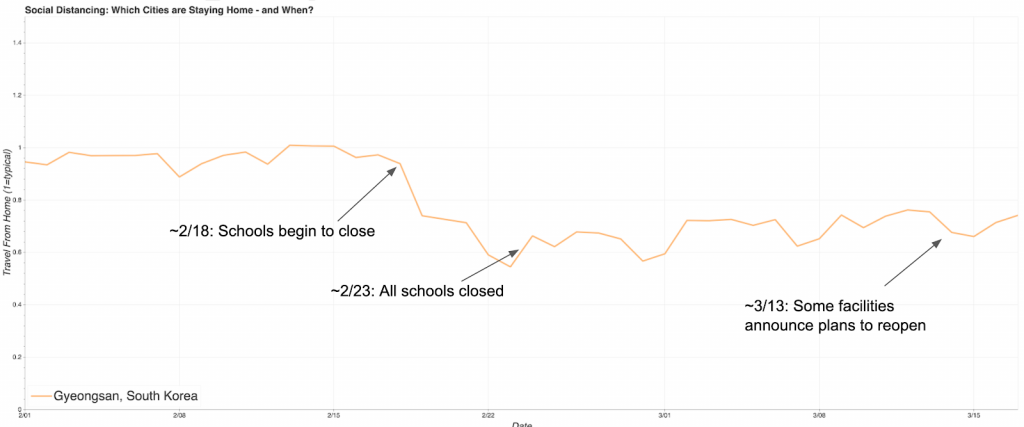How much have Americans in select US cities reduced their travel away from home compared to Italy and South Korea?
Background
The term “Social Distancing” has rocketed to the forefront of American life after becoming the primary means of slowing or stopping the spread of COVID-19. Social distancing is a public health practice that attempts to reduce the number of opportunities for sick people to come into close contact with healthy people and therefore stop the spread of the virus. It can include mandatory closure of large events and gatherings as well as personal measures like maintaining physical distance between individuals.
One question on Americans’ minds has been whether or not various states and metro areas have enacted strong enough social distancing policies in time to be on a similar infection trajectory to South Korea, or if they are on a trend that more closely follows Italy.
South Korea took immediate action, enacting harsh social distancing policies quickly after detecting their first cases of COVID-19, while Italy did not take immediate action and slowly rolled out social distancing in a staged manner beginning with the Lombardy region. Infection rates were suppressed in South Korea and continue to rise sharply in Italy, thanks in part to their respective approaches to social distancing.
Objective
In this study, our objective was to examine the behavior of Americans in select US cities, and determine if their levels of social distancing closer match those of the
Methodology
In any given community of interest we can study how many devices leave home on a typical day, controlled for day of week and seasonal trends. 1.0 represents a typical day of people leaving their home for school, work, shopping, etc. 0.0 represents every mobile device is in its home all the time.
Analysis
Gyeongsan, South Korea
Traveling Away From Home: South Korea

Slightly below average leaving home in the days leading up to social distancing, and then a significant drop.
Traveling Away From Home: South Korea

The first significant drop is on February 18 when schools begin to close, and in looking at the timeline for South Korea’s response to COVID-19, South Korea started social distancing before the COVID-19 cases began increasing quickly.
Traveling Away From Home: South Korea

By comparing this chart to the increase in cases of COVID-19 in South Korea (the highlighted bar chart above), when the daily new cases were high in South Korea, you can see that they weathered the first big event and are scaling back their social distancing policies. The data reflects how there is more social distancing now than in the initial days of the outbreak.
Florence, Italy
Traveling Away From Home: Milan, Italy

Italy displays typical amounts of travel from home leading up to the first COVID-19 related events, where the country took a phased approach to quarantines. Florence was finally put on quarantine on March 11. The amount of social distancing was a slight decrease over time with a sharp decrease on March 11 when the nationwide quarantine was put into effect.
Traveling Away From Home: Milan, Italy

The amount of isolation in Florence in recent days has been extremely high, which may be related to the amount of cases of COVID-19 in Florence being very high.
United States
Traveling Away From Home

Los Angeles and Seattle appear to be slightly ahead of the curve regarding isolating before the amount of COVID-19 cases picks up.
Conclusion
South Korea and Italy can be used as baselines for communities to better understand what they should expect when confronting COVID-19 in their own regions. This type of analysis can be applied to any other regions, simply by analyzing the amount of devices that leave home during a given amount of time over the course of a COVID-19 outbreak.
Azira copyright notice and disclaimer: No reproduction or use is permitted without Azira’s express written consent.



